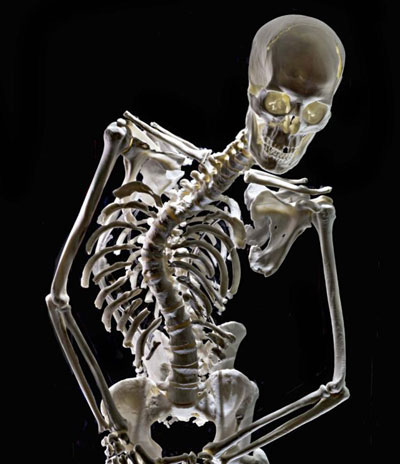Delete oan for King Richard III
King Richard III may be the most famous hunchback in British history, but recently experts discovered it seems that Shakespeare is too exaggerating the deformity of this king.
>>>Diagnose for King Richard III
A scan of the skeleton of King Richard III determined that he was only slightly deformed in the spine and did not affect his appearance or ability to attack on the battlefield.

X-ray and 3D modeling of King Richard III's remains - (Photo by University of Leichester)
The most famous phrase that the great English poet William Shakespeare used to describe King Richard III is "the humpy toad" .
However, in fact, the three-dimensional reconstruction model showed that the king's spine was bent to the right from 65 to 85 degrees, and the medical community judged that he could not be hunched, according to medical advice. The Lancet reports the University of Leichester, England.
Although one shoulder is slightly taller than the other and is shorter than the arms and legs, there is no concrete evidence that he is handicapped.
Unlike the depictions in plays, Richard III's head and neck remain in a straight position, without tilting or twisting to one side.
King Richard III was unearthed under the Leichester parking lot in 2012, after more than 500 years of missing since the defeat of King Henry VII in the Battle of Bosworth in 1485.
- King Richard III will be buried
- Revealed inside the tomb of King Richard III
- Diagnosis for King Richard III
- Question: The location of King Richard III's tomb in England is in the car park
- It has not been decided where to bury King Richard III
- Find out the cause of King Richard III's death
- Preserve the King of England with 3D technology
- Find the British king's remains under the parking lot
- The luxurious diet of the ancient king of England
- Very interesting truth about British emperors
- One of the most mysterious cases in British history will be decoded, if ...
- Who is BB King and what is Google celebrating today?
 Discovered an ancient centipede fossil 99 million years old
Discovered an ancient centipede fossil 99 million years old Discovered bat-like dinosaurs in China
Discovered bat-like dinosaurs in China Discovered a 200-year-old bronze cannon of the coast
Discovered a 200-year-old bronze cannon of the coast Discover 305 million-year-old spider fossils
Discover 305 million-year-old spider fossils Rare photos of royals around the world 100 years ago
Rare photos of royals around the world 100 years ago  Can a king cobra kill an African elephant?
Can a king cobra kill an African elephant?  Close-up of Vietnam's 'Roman arena'
Close-up of Vietnam's 'Roman arena'  Extremely ferocious snakes, but useful to farmers
Extremely ferocious snakes, but useful to farmers  Giant king cobra stands up straight like a human, creating a terrifying scene
Giant king cobra stands up straight like a human, creating a terrifying scene  The snake has a scary name and resembles a poisonous snake but is harmless
The snake has a scary name and resembles a poisonous snake but is harmless 